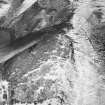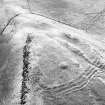Pricing Change
New pricing for orders of material from this site will come into place shortly. Charges for supply of digital images, digitisation on demand, prints and licensing will be altered.
Dumglow
Cairn (Bronze Age), Tree Trunk Coffin (Bronze Age)
Site Name Dumglow
Classification Cairn (Bronze Age), Tree Trunk Coffin (Bronze Age)
Alternative Name(s) Cleish Hills; Drumglow
Canmore ID 49642
Site Number NT09NE 4
NGR NT 07589 96503
Datum OSGB36 - NGR
Permalink http://canmore.org.uk/site/49642
- Council Perth And Kinross
- Parish Cleish
- Former Region Tayside
- Former District Perth And Kinross
- Former County Kinross-shire
NT09NE 4 0759 9649.
(NT 0759 9649). A cairn, 50' in diameter and 5' high stands on the summit of Dumglow, within the fort NT09NE 2. When excavated in 1904 the upper levels of the cairn were found to have been permeated with molten tar and the melted glass of whisky bottles, as a result of successive bonfires having been built upon it." Deeper, the cairn was found to be waterlogged. At a depth of 6'7" below the centre of the top of the cairn, the excavators found the remains of a hollowed tree-trunk 7' long which may have been a tree burial.
J Abercromby 1905; R W Feachem 1963.
This cairn measures 19.0m E-W by 18.5m and is 1.7m high. The top has been flattened and now supports an OS triangulation pillar.
Surveyed at 1:10,000 scale.
Visited by OS (BS) 19 February 1974.
The cairn that is situated within the fort on the summit of Dumglow (or Drumglow), and at an altitude of 379m OD, measures 50' (15.3m) in diameter and 5' (1.5m) in height. In 1904 it was excavated by trenching and found to be of earthen construction with a capping of stones.
In the centre (aligned E-W at a depth of 2m below the highest point) there were found the decayed remains of a 'hollowed-out tree-trunk of oak' which measured 7'1" (2.2m) in length by up to 11" (279mm) in breadth. Although neither human remains nor grave-goods were found, this was identified as a log-coffin.
Childe suggests an attribution to the Bronze Age on the analogy of comparable English examples of Food Vessel association.
J Abercromby 1905; RCAHMS 1933; V G Childe 1946; R W Feachem 1977; R J C Mowat 1996.
Field Visit (2 August 1927)
Cairn, Drumglow.
A cairn lies within the defences of the fort, on the crest of Drumglow Hill. It has a diameter of 50 feet and rises to a height of about 5 ½ feet. It was examined in 1904, when a portion of a hollowed out tree-trunk of oak, measuring 7 feet 1 inch by 11 inches at the broadest part, was discovered in the centre at a depth of 6 feet 7 inches from the top of the cairn. "Although itis not quite certain, it is highly probable that under the Dumglow mound we have an instance of tree-coffin burial" (1). The situation of this cairn within the precincts of a fort is a feature of special interest. A bronze-age cairn was noted within the fortifications on Birrenswark or Burnswork Hill, Dumfriesshire (2).
RCAHMS 1933, visited 2 August 1927.
Proc. Soc. Ant. Scot., xxxix (1904-5), pp.179-81. (2) Inventory of Monuments and Constructions in the County of Dumfries, p. 98.






























































